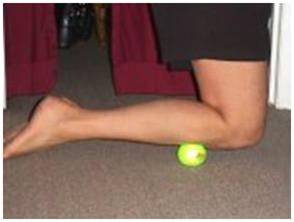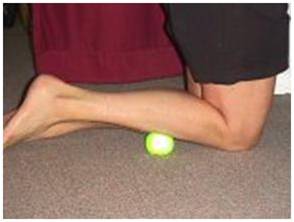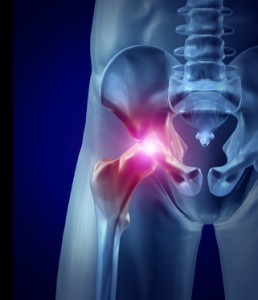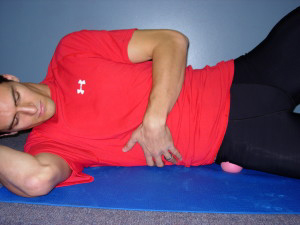You Can Make Your Foot Pain Go Away
Author: Julie Donnelly
Just a couple of weeks ago I taught you how to make your hip pain go away. Today’s topic is foot pain. And, yes, you can make your foot pain go away as well. But, let’s start at the beginning.
How Does Foot Pain Get Started?
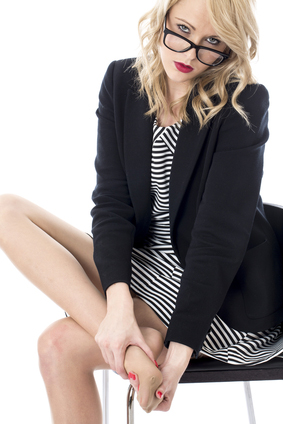
You feel it coming on gradually. Maybe your lower leg aches a bit, but you’re busy so you ignore it. After a while every time you take a step you feel a burning that spreads along the entire lower leg and into your arch. Still you ignore it. But it doesn’t go away, in fact, it gets worse.
Now your arch just doesn’t feel “right.” Then it starts to hurt, but not every time you put pressure on your foot. Again, you ignore it until finally you are experiencing foot pain all the time. Then eventually you can’t ignore it any more, it’s like a knife being jabbed into your arch. Now it’s not just hurting when you run or drive your car, your foot hurts with every step.
Almost every day you do something that causes you to lift the front of your foot while your heel is still resting on the floor. For most people it comes from straining your lower leg muscles when you are driving a car, especially if you drive often. It is even more evident if you are doing any type of city driving because you are off and on the gas and break constantly, repetitively straining all of your lower leg muscles. You just know that your foot hurts and it’s affecting your life. You must find a solution!
What is Plantar Fasciitis?
You’ve been told you have plantar fasciitis, and you may have been told you need expensive orthotics. Perhaps you’ve even tried them and while they worked for a short time, eventually the pain returned and then it started to hurt worse. Now you’re told you need to replace the orthotics, but you’ve come to realize that isn’t the answer. And it’s not the answer. The orthotics are focusing on the symptom, but totally ignoring the source of the problem.
The good news is that you can heal your plantar fasciitis naturally. Most people, including too many medical professionals, don’t realize that foot pain is frequently coming from outside the foot. The muscles of your lower leg actually are there to move your ankle and foot, not to move your lower leg (that comes from your upper leg).
The reason is simple. First let’s use an analogy that I use all the time because it’s so perfect to explain how muscles work to move a joint. If you pull your hair at the end, it hurts at your scalp. You don’t need to massage your scalp, you don’t need to take pain medications to stop the tension in your head, and you certainly don’t need brain surgery, you just need to stop pulling your hair! Now substitute the muscle for your hand, the tendon for your hair, and the joint for your scalp.
Muscles originate in one place, they merge into a tendon that crosses over a joint, and then the tendon inserts into a point on the other side of the joint. When the muscle pulls, the tendon tightens and the joint moves, but if the muscle is tight it will continue pulling on the joint even when you don’t want it to move. In the case of the lower leg muscles and the foot, the muscles are pulling your foot up from the ground, but you are pressing it down and causing the tendons to put a strain on the insertion points, which in this case are all in your arch.
How the Muscles Get Strained
Every time you take a step you are using all of the muscles of your lower leg. As you work you contract these muscles every time you step on the pedal. Lifting the front of your foot up you are using your tibialis anterior and then you press down on the pedal you are using your calf muscles. If you walk a lot, or you are a runner, you are causing a repetitive strain on the same muscle fibers. Also, while driving your car your foot is picked up in the front to go from the gas to the brake, again straining the same muscles. You do this over and over until you have strained the muscle fibers. Eventually the fibers shorten due to a phenomenon called muscle memory.
Muscle memory will hold your muscles in the shortened position even when you don’t need them contracted. This puts pressure on the insertion point, in this case, the arch.
The Result is Arch Pain
The two primary muscles that cause arch pain are the tibialis anterior and the peroneals. They originate at the top of the lower leg, merge into tendons where your ankle begins to slim, and then insert into the bottom of your foot.
The tibialis anterior goes along the outside of your shin bone, crosses over the front of your ankle and then inserts into your arch. When it contracts normally you lift up the inside of your foot so you are resting on the outside of your foot.
The peroneals originate at the top/outside of your lower leg, run down the leg and merge into a tendon that goes behind the outside of your ankle and inserts in two places; the outside of your foot, and under your arch to the inside of your foot. When it contracts normally you pull up the outside of your foot so you are resting on your big toe.
An Easy Treatment that Works
The goal with this Julstro self-treatment is to force the toxins out of the muscle fibers, drawing in blood to nourish the muscles. As the blood fills the muscle, the fibers lengthen and the strain is removed from the arch.
Begin by treating the tibialis anterior on the front of your leg.
#1 – kneel on the floor and put a ball just outside of your shin bone.
#2 – Move your leg forward so the ball rolls along the outside of your shin bone.
Then treat the peroneals on the outside of your lower leg, sit on the floor with the leg you are treating bent and resting on the floor. Put the ball on the outside of your leg (so it is actually on the floor and your leg is on top of it) and then press the outside of your leg into the ball. Move your leg so the ball starts to roll down the outside of your lower leg. Your intention is to do the same as you did for the tibialis anterior (above)
Or, sit on the floor or a bed and position your leg as shown in picture #3. While using either a dowel or a length of PVC pipe, slide the pipe from just above your ankle bone to just below your knee joint.
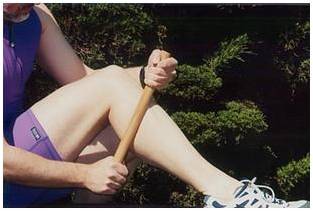 #3 – Using a dowel or piece of PVC pipe, put pressure on the outside of your leg and slide along the peroneals muscle from your knee to above your ankle bone.
#3 – Using a dowel or piece of PVC pipe, put pressure on the outside of your leg and slide along the peroneals muscle from your knee to above your ankle bone.
The treatments will feel sore but that’s because you’re forcing H+ ions through the muscle fibers, and acid burns. But, it’s better to have the toxins out of the muscles and fill the fibers with blood, plus the lymphatic system will pick up the toxins and eliminate them from your body.
There are several other treatments that work to eliminate arch pain and plantar fasciitis, but I’ve found these to be the most productive, and they may be all that is necessary to eliminate the problem completely.
These statements have not been evaluated by the Food and Drug Administration. This information is not intended to diagnose, treat, cure or prevent any disease.

